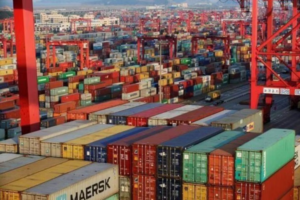As India sets its sights on achieving a $2 trillion export target by 2030, evolving global trade realignments, shifting supply chain dependencies, and rapid air logistics advancements are opening fresh opportunities for growth. Increasing demand for high-value, time-sensitive goods, along with investments in cargo infrastructure, multimodal connectivity, and digitalisation, is strengthening India’s international competitiveness. In this feature, industry leaders offer expert perspectives on how air cargo can accelerate export expansion, enhance resilience, and successfully propel India’s trade ambitions to the next level.
As India charts its course toward a $2 trillion export target by 2030, the air cargo industry is fast emerging as one of the most vital engines of this transformation. With global trade routes shifting, geopolitical dynamics evolving, and technology reshaping logistics, air freight has become the bridge that connects India’s production prowess with the world’s demand. Leaders across the logistics and air freight ecosystem share their perspectives on how air cargo is set to power India’s export journey during the Amrit Kaal.
Expanding connectivity and fair trade

“Air cargo democratises export capabilities across all of India.”
Opening the discussion, Samir J Shah, President, ACAAI, emphasised that logistics is what keeps the world moving, and air cargo lies at the heart of it. He pointed out that the rapid development of new airports across India will soon enable even remote regions to send and receive specialized cargo, thus democratising export capabilities. “All parts of India will soon be able to receive and send different types of cargo, especially those requiring air freight,” he stated.
Shah also highlighted India’s growing self-reliance and diplomatic independence in global trade. “India has always been non-aligned and believes in fair trade over free trade,” he remarked, noting that the nation’s unique geographical advantage on the Europe–Far East trade lane and its global diaspora provide strong export opportunities. With ongoing reforms in the Foreign Trade Policy and local taxation, he believes the foundations for exponential growth are already being laid. He further emphasised the role of regional connectivity, pointing out that “leveraging the Customs Act, ICEGATE, and extending permissions for air cargo movement from CFSs will make cargo operations faster and more competitive.” These developments, he added, will ultimately strengthen India’s multimodal ecosystem
Scaling air freight for a $2 trillion vision

“Speed, reliability, and high-value handling make air cargo indispensable.”
Building on this view, Dr Vandana Singh, Chairperson, Aviation Cargo – FAII, observed that air cargo will be instrumental in realising India’s $2 trillion export vision. “Its speed, reliability, and ability to handle high-value, time-sensitive shipments make it indispensable for sectors like pharmaceuticals, electronics, and perishables,” she said. With India handling about 3.26 million tonnes of air cargo in FY2024 and targeting nearly 10 million tonnes by 2030, she underlined the importance of scaling infrastructure and connectivity.
Dr Singh elaborated on how digitalisation and multimodal integration will be key to this transformation. “Expanding freighter connectivity, digitising processes, and integrating multimodal logistics will enhance efficiency and scale export throughput,” she explained. As global trade patterns evolve, she believes India must tap into emerging markets by expanding direct air links and developing specialised logistics for tariff-sensitive goods. She also drew attention to the role of regional cargo hubs and Dedicated Freight Corridors (DFCs) in optimising costs and transit time, asserting that these initiatives would “make air cargo flows faster and more predictable, strengthening India’s competitiveness.”
Leveraging the China+1 opportunity

“Air cargo accelerates exports and strengthens MSME global access.”
Echoing this optimism, Keku Bomi Gazder, MD & CEO, Aviapro Logistic Services, emphasized the strategic role of air cargo in accelerating India’s $2 trillion export target during Amrit Kaal. “Air cargo can significantly accelerate India’s journey by enabling faster, reliable movement of high-value and time-sensitive goods like electronics, semiconductors, pharmaceuticals, and perishables. It supports MSMEs in accessing global markets, boosts supply chain efficiency, and strengthens multimodal logistics. Continued investments in cargo infrastructure, digitisation, and policy reforms can further enhance air cargo’s strategic role in export growth,” he noted.
He added that India can leverage emerging trade realignments and tariff shifts by positioning itself as a reliable alternative in global supply chains, especially amid China+1 strategies. “By capitalising on FTAs, reducing logistics bottlenecks, and enhancing air cargo connectivity, India can attract more export demand. Targeting high-growth sectors such as electronics, semiconductors, and pharmaceuticals will further boost air export volumes amid shifting global trade dynamics,” Gazder explained.
On the development of regional cargo hubs and dedicated freight corridors, he observed, “These hubs are enhancing India’s air logistics competitiveness by improving connectivity, reducing transit times, and decongesting major airports. They enable efficient handling of exports from Tier 2 and 3 cities, while freight corridors streamline multimodal transport. Together, they support faster, cost-effective cargo movement, attract global trade, and strengthen India’s role in international supply chains.”
Air cargo: A critical accelerator

“Air freight ensures competitiveness and supports high-value, time-sensitive sectors.”
From a strategic and operational perspective, Vipin Vohra, Chairman, Continental Carriers, highlighted air cargo as a “critical accelerator” in India’s journey toward its $2 trillion export target by 2030. “Air freight provides the necessary speed, security, and reliability for high-value and time-sensitive sectors like pharmaceuticals, electronics, and e-commerce, ensuring Indian goods remain globally competitive,” he said. Vohra noted that tripling air cargo capacity, alongside digitising processes, will reinforce India’s manufacturing and export ecosystem, supporting initiatives such as Make in India and Production Linked Incentive (PLI) schemes, and driving both merchandise and services exports toward the $1 trillion targets each.
He emphasised that emerging trade realignments, including the China Plus One strategy and shifting tariffs, present a rare opportunity for India to diversify trade lanes, particularly toward Russia, Europe, and Asia. “By simplifying customs, leveraging Free Trade Agreements (FTAs), and offering high-tech handling with minimal red tape, India can quickly absorb redirected high-value export volumes, positioning air freight as the preferred and cost-effective mode,” Vohra explained.
On infrastructure, he added, “The development of regional cargo hubs and Dedicated Freight Corridors, supported by PM Gati Shakti, creates a seamless multimodal network linking inland manufacturing centres to air gateways. Digital systems for end-to-end cargo visibility, combined with active private sector participation, will reduce transit times and costs, making Indian exports faster, cheaper, and more reliable on the global stage.”
Europe emerging as a growth market

“Infrastructure and multimodal hubs will make Indian exports faster.”
Complementing this, Jaideep Mirchandani, Group Chairman, Sky One, highlighted the dynamic shifts in India’s air export markets. “U.S. tariffs have affected India–U.S. volumes, which, according to WorldACD Market Data, saw a decline of 8 percent in week 37 (8–14 September), following drops of 12 percent and 11 percent in the previous two weeks after a 28 percent surge in week 34 just before the U.S. introduced new 50 percent reciprocal tariffs on Indian goods. With weekly cargo now 14 percent below the three-month average, exporters are strategically redirecting capacity to Europe, which has emerged as a stable growth market,” he explained. “Government support is encouraging exporters to diversify, expand product ranges, enter new regions, and rely less on a single trade partner.”
He added that with India aiming for an annual air cargo capacity of 10 million metric tonnes by 2030, strengthening infrastructure is crucial. “This includes building new cargo terminals, modernising existing ones, and establishing dedicated cargo hubs. Integration with multimodal transport, especially under the Maritime India Vision 2030, will ensure seamless, cost-effective movement of time-sensitive goods from production centres to ports and overseas markets,” Mirchandani said, emphasising the strategic alignment of air cargo with India’s long-term maritime and logistics vision.
Air cargo as a strategic enabler

“Specialised hubs and cold-chain infrastructure boost MSME export potential.”
Extending the conversation, Dhruv Raj Sirohi, Supply Chain Leader, emphasised that air cargo is a strategic accelerator, not merely a transport service. “Air cargo delivers speed, trust, and value capture, amplifying value density for high-value, time-sensitive goods such as pharmaceuticals, electronics, perishables, and gems,” he explained. Sirohi highlighted India’s position among the top six global air cargo markets and the pivotal opportunity under Vision 2047 to reposition airfreight as a strategic pillar in the country’s economic transformation.
He pointed out that in times of tariff shifts and global trade realignments, “speed and reliability become differentiators, enabling faster payments, lower inventory costs, and stronger trust from buyers.” Leveraging India’s geographical advantage, the country can become a transshipment hub connecting Asia, Africa, Europe, and the Middle East, while also redirecting goods into premium markets like Europe, North America, Japan, and Korea, where speed, quality, and reputation yield higher margins.
Sirohi further stressed the role of regional cargo hubs, dedicated freight corridors, and specialised facilities, such as cold chain ramps for pharma and seafood and electronics hubs near manufacturing clusters, to reduce door-to-aircraft times, minimise spoilage, and cut logistics costs. “By connecting Tier 2 and Tier 3 cities directly to global markets, integrating rail air corridors, and aligning infrastructure with local economic strengths, we can democratise exports for MSMEs,” he noted. With these measures, he targets a doubling of output from regional hubs within three years, achieving less than 24 hour door-to-aircraft times for prioritised clusters, and raising India’s air export share by up to 30 percent.
Building resilience through diversification

“Optimised routes and capacity build resilience in India’s exports.”
Adding a pragmatic lens, Vinet K. Chadha, Founder & Managing Director, Combined Logistics, reiterated that air cargo remains a “key driver” for India’s export expansion. “The combination of speed, reliability, and global reach allows exporters to remain competitive, particularly for high-value and time sensitive goods like pharmaceuticals, electronics, and perishables,” he said. With shifting U.S. tariffs prompting diversification, Chadha highlighted that exporters are now turning toward Europe, Southeast Asia, and the Middle East. He emphasised that “optimised air routes, expanded capacity, and upgraded airport infrastructure, coupled with integrated multimodal connectivity, are essential to sustain momentum and build resilience in India’s trade network.” Chadha also noted that the development of regional cargo hubs and dedicated freight corridors is transforming air logistics by streamlining customs, consolidating shipments, and reducing last-mile delays. “Together, these initiatives position India as a resilient and agile air export hub, strengthening our long-term competitiveness in global trade,” he concluded.
Public–private synergy for growth

“Investing in world-class infrastructure catalyses export-led economic growth.”
Further strengthening this outlook, Sunil Kohli, Managing Director, Rahat Cargo, emphasised the critical role of air cargo in driving India’s export ambitions during Amrit Kaal. “India’s journey toward meeting its $2 trillion export target can be accelerated by providing speed, efficiency, and global reach for high value, time-sensitive goods such as pharmaceuticals, electronics, and perishables like fruits and vegetables. The government’s strategic initiatives, coupled with infrastructure projects and supportive policies for the cargo trade, act as a catalyst to drive export-led economic growth,” he noted. “The cargo industry should also explore new export markets, build resilient supply chains, and integrate further with global value chains. To fully realise this potential, investments in world-class infrastructure and the development of Tier 2 and Tier 3 airports into dedicated air cargo hubs with state-of-the-art logistics capabilities are essential.”
On leveraging trade realignments and tariff shifts, Kohli observed, “Recent global developments, including geopolitical disruptions such as the Red Sea crisis, have pushed more cargo from sea to air, creating opportunities for Indian exporters. Companies are diversifying supply chains to mitigate risks, and entering into Free Trade Agreements (FTAs) with friendly countries can remove trade barriers and enhance market access, helping India expand its air export volumes strategically.”
He further highlighted the role of regional cargo hubs and dedicated freight corridors in strengthening India’s air logistics competitiveness. “These hubs reduce congestion at major airports, allow faster cargo movement at lower logistics costs, and provide seamless, efficient supply chains for goods moving in and out of cargo hubs. Equipped with such facilities, India can enhance its position in global trade and emerge as an attractive transshipment hub for international cargo,” Kohli said.
Collaboration: The growth engine of Amrit Kaal

“Collaboration, digitisation, and multimodal connectivity drive India’s air cargo growth.”
Bringing the discussion to a close, V. Chandra Kumar, Founder & Managing Director, Active Freight Logistics, emphasised that collaboration is the cornerstone of India’s air cargo growth. “Air freight is central to high-value, time sensitive exports, linking pharmaceuticals, perishables, electronics, and precision engineering products from Indian industries to global supply chains,” he said. Kumar highlighted that strengthening cargo infrastructure, digitising customs, and integrating multimodal connectivity are vital to scaling operations efficiently.
He noted that the development of new airports like Navi Mumbai and Noida, along with modernised hubs in Bengaluru and Hyderabad, equipped with dedicated express and perishable cargo facilities, will decongest gateways and expand capacity. “Coupled with regional cargo hubs and Dedicated Freight Corridors, this will enable faster, cost-effective movement of goods from Tier 2 and Tier 3 cities, opening global market access for MSMEs,” Kumar explained.
Pointing to trade opportunities, he added, “Leveraging PLI schemes, Free Trade Agreements, logistics reforms, and initiatives like PM Gati Shakti, India can attract investments, strengthen export competitiveness, and navigate global trade realignments and tariff shifts.” He concluded, “By aligning policy, infrastructure, and stakeholder collaboration, air cargo will emerge as the growth engine driving India’s $2 trillion export milestone during the Amrit Kaal.”
Strengthening air connectivity through trade realignments

“Trade realignments are positioning India as a premium global export hub.”
Adding an international perspective, Giridharan Srinivasan, Area Manager, ISC Region, Etihad Cargo, emphasised that achieving India’s $2 trillion export target under the Amrit Kaal vision will depend on a resilient, well-integrated air cargo ecosystem. “Air cargo enables speed, reliability, and value capture for high-value, time-sensitive exports such as pharmaceuticals, perishables, and electronics,” he noted, stressing that corridor-based initiatives like the Hyderabad Pharma Corridor are already enhancing efficiency and predictability in critical sectors.
On navigating global trade realignments, Srinivasan observed, “Shifting trade routes and tariff changes are creating an opportunity for India to emerge as a sourcing hub for premium cargo.” He highlighted that free trade agreements such as the India–UAE CEPA, along with proposed agreements with the UK and EU, “open new export channels, reduce barriers, and strengthen global access.” He added that expanding Tier-II export hubs, improving digital connectivity through platforms like the National Logistics Portal, and providing targeted f inancial incentives “will empower MSMEs to integrate seamlessly with international supply chains.”
Speaking on infrastructure evolution, Srinivasan stated, “Regional cargo hubs and Dedicated Freight Corridors are reducing transit times, decongesting gateways, and improving reliability across multimodal networks.” He emphasised that initiatives such as Krishi Udaan 2.0 “boost competitiveness for perishable and agricultural exports,” while continued investments in digitalisation, sustainability, and skill development “are positioning India as a resilient, future-ready global air logistics hub.”
Together, these voices reflect a powerful consensus: India’s air cargo sector is no longer just a facilitator of trade; it is a catalyst for transformation. As trade routes evolve and infrastructure strengthens, air logistics will continue to propel India’s exports skyward, guiding the nation closer to its $2 trillion dream.











